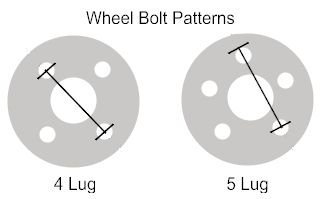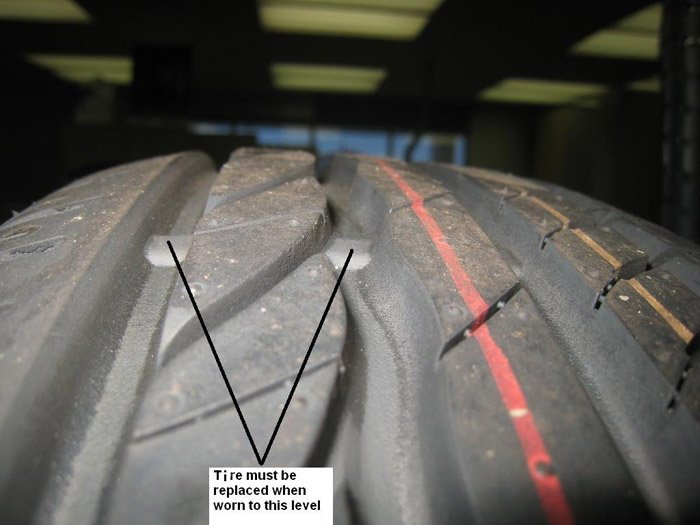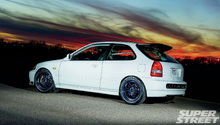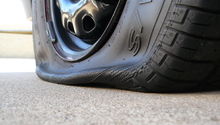Honda: Tires General Information and Specs
Tires are the four patches of rubber that connect the car to the road; it's not an area to skimp out on. Read up on this pertinent tire information.
This article applies to all Honda models.
Having the right tires for your ride can improve handling and precision, not to mention safety. Along with the tires themselves, there are various components and attachments to help keep the tires attached to the vehicle. These components work together for a smooth ride, even in poor weather conditions.
There are three basic types of tires on the market: summer tires, designed for warm weather driving, all-season tires for year-round use, and snow tires. Most cars come standard with all-season tires. The OEM tires are suitable for year-round use in most parts of the country. Some performance models can handle larger wheels, which suit tires with a wider tread and lower aspect ratio. This combination leads to increased handling and cornering capability.
You can find specific tire information on your car's driver side door or in the owner's manual. Most placards tell you sizes for the front and rear sizes along with the recommended pressure for standard tire sizes. In some cases, the placards also have ranges to let you know what is (and isn't) likely to fit on your car.
(Related Article: Honda: High-Performance Tire Review - Honda-Tech.com)

Wheels
Wheels are a great way to personalize your car. There is a wide selection available, from OEM to custom wheels. There are two main types to consider: steel and aluminum alloy wheels. Steel wheels rely on rolled steel, which makes them heavier than aluminum alloy wheels. Additionally, steel wheels are more durable, easily resisting cracks and bends. It's pretty common for people to roll on "steelies" in the winter time. On the other hand, aluminum alloy wheels are lighter in weight and are stronger than steel when measured pound by pound. Advantages of this lighter-weight construction include faster acceleration and stopping. Steel wheels are often more affordable but have a limited option of sizes and styles. Alloy wheels offer unique styles and match a wide range of budgets.

Wheel Bolt Patterns
Tire bolt patterns are important for replacing or customizing wheels. Honda Civics up until the 8th generation (2006+) had a 4x100 bolt pattern, while the newer cars have a 5x114.3 bolt pattern. When broken down, this pattern means that there are five holes for placing bolts into the wheels and mounting them. The 114.3 designates the diameter of the wheel's bolt circle. However, measuring a wheel's exact diameter can be tough, especially on a five-bolt pattern wheel.

Scheduled Maintenance
If you still take your car to the dealership for service, it's pretty common that they will inspect your tires, among other things. However, you can assess your tire's health quite easily in between checkups with nothing but a penny. Stick a penny upside in the tread voids; if Lincoln's full face is visible looking back at you, it's time to replace. This amount of wear is usually about 2/32", and a brand new tire usually measures about 10/32". All tires are sold with a tread wear indicator, which is a raised bar of material 2/32nd of an inch across the tire's tread. When the tire wears down to the indicator, it is no longer legal on the road and requires prompt replacement.

Common Questions
One tire keeps losing air. Should I replace it?
Not necessarily. The most common cause of a single tire that keeps losing air is a slow leak, and that is due to debris that gets stuck in the tire. In this case, the culprit is often a nail. For best results, take the car to a shop as it often needs to be removed from the rim to be fixed properly. While you're there, the mechanic can also recalibrate your Tire Pressure Monitoring System (TPMS), if applicable, once the tire is fixed.
Do I need to replace all four tires if only one is bad?
Replacing tires is costly, especially if you have to replace them all at once. Unfortunately, this is often recommended even if just one tire is bad. This is mainly because it's best if all four tires wear evenly. Putting on a new tire with three worn ones creates a difference in tire size, which could negatively impact the vehicle's performance and safety. If it really comes down it, replace the axle pair if your can't do all four at once. Tire rotations are cited in the Honda Owner's Manual as to be performed every 5,000 miles (or every oil change).
(Related Article: Honda: How to Check Your Tire Pressure - Honda-Tech.com)
Can I extended the life of my tires by swapping them from one side to another?
In some cases you can extended the life of the car's tires by moving them from one side to another. For example, if the outer edges on both sides are worn, you may be able to swap the tires so that the inner edge is now on the outside. However, this only works on vehicles with directional tires. Asymmetrical tires have a clear inside and outside, meaning that you cannot substitute one side for the other by swapping tires.
Common Issues
My TPMS system (or similar warning) is on
You may need to recalibrate the TPMS system. A mechanic often takes care of this for you. If you recently replaced or rotated your tires and are seeing a TPMS light or similar warning, the tires may be the wrong size. It should be noted that earlier model Civics and Accords do not have TPMS.
The tops of my tires rub when turning the car
Tires rubbing on the wheel wells of your car are generally a bit too big for the vehicle. Depending on the size discrepancy, this may be more of a nuisance than an actual hazard. Tires that are too big for the car may alter the vehicle's handling and performance.
(Related Article: Honda: Tire Modifications and Size Calculator - Honda-Tech.com)
My car pulls to the left and/or right
A car that "pulls" to one or more sides often requires an alignment. For best results, bring the car in to a professional to have the alignment checked. In many cases, mechanics often balance the tires at the same time to help extend the life of the tires.
(Related Article: Honda: How to Align Your Tires - Honda-Tech.com)
Related Discussions
- Best Street Tires? - Honda-Tech.com
- Street Tires Good Traction - Honda-Tech.com
- Affordable 15" Tires - Honda-Tech.com






